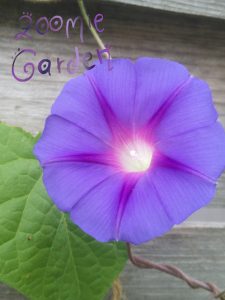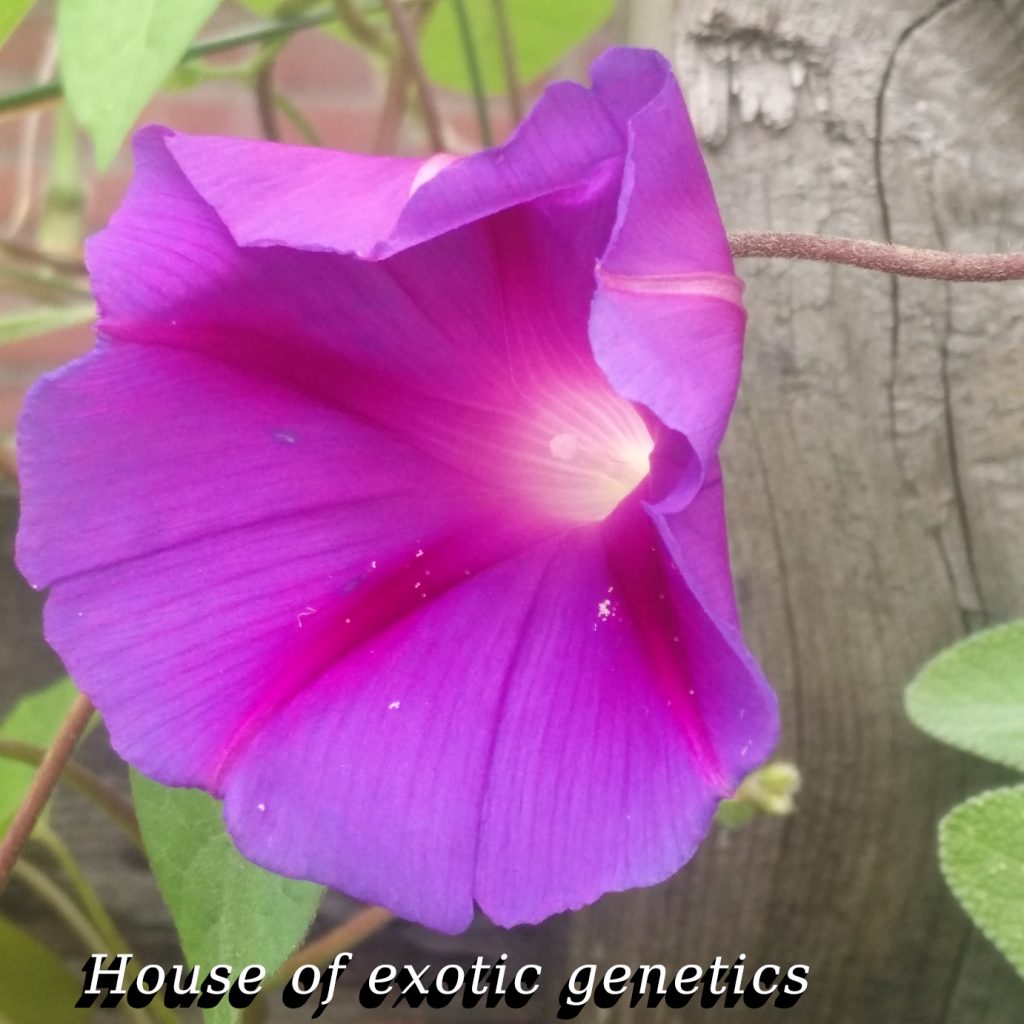
Morning Glory ~ Ipomea purpurea

Ipomea purpurea, called also Tall Morning Glory or Common Morning Glory, is a fast-growing vine, native to the tropical areas of America and naturalized in most countries of the world. It grows from seed in Springs, producing flowers and seeds until the first cold when the plant will end its vegetative circle. Is mainly grown for ornamental purposes.
Description – Ipomea purpurea
“Morning Glory” is a common name that includes over 1000 species of plant family Convoulvacae.
–
Tall Morning Glory or Ipomea purpurea is a trailing or twinging wine, characterized by purple flowers, from deep-violet to light purple/pink. The flowers bloom in the early morning and close up as soon as the sun rays hit them. Every flower last usually just half of a day. Every fruit will produce 4 or more black seeds. The leaves are “cordiform”, shaded like a heart, or deeply trilobate. Ipomea purpurea and other Morning Glories are climbing plants, and they will twine around fences, walls and even other plants!
Botanical description
Herbaceous vine, twining, 2-3 m in length. Stems cylindrical, slender, pilose or hirsute.
(Acevedo-Rodríguez, 2005).
Leaves alternate; blades simple, 2-10 × 2-10 cm, cordiform or deeply trilobed, the lobes ovate orlanceolate, chartaceous, strigulose on both surfaces, the apex acuminate, the base cordiform, the margins entire or slightly sinuate, ciliate; upper and lower surface with the veins slightly prominent; petioles 2.5-6 cm long, slender, strigulose, sulcate. Flowers solitary or in simple dichasia, axillary; peduncles longer than the petioles; bracts subulate, approximately 3 mm long, not forming an involucre. Calyx green, of 5 subequal sepals, 8-16 mm long, chartaceous, oblong lanceolate, the outer ones slightly broader than the inner ones, acute at the apex, hirsute outside on the basal portion; corolla blue, purple, pink, or with lines (forming a star) of these colours on a white background, 4-4.5 cm long, the throat white, limb with shallow, rounded lobes; stamens and stigmas pink, not exserted. Capsule, 9-10 mm in diameter, glabrous, the pericarp thin, with the chartaceous sepals persistent at the base; seeds 4 per fruit, pyriform, 3-4 mm long, black, glabrous

Grow Ipomea purpurea
Ipomea purpurea is very easy to grow from the seed. Is also possible to propagate by cutting a branch of the plant.
Germination
The seed can be sown directly in the soil or placed for 10 hours in water (not cold) to catalyze germination.
–
It will take 7 to 14 days for 50/60% of the seeds to grow, developing the first leaves (cotyledons).
The remaining part of the seeds will germinate later during the season.
–
The temperature needed for germination is between 20 and 25°C. Lower temperatures slow down the growth. Temperature around 0°C might block totally the germination of the seed.
Soil
Ipomea purpurea can tolerate a wide range of soil, better if well-drained.
Classic soil mixes are:
– peat soil and perlite/clay
– coconut fiber
– peat soil and sand

Grow in a pot
Grown Morning Glory in a pot has some advantages:
– Is possible to keep the pot with the seeds in a warm place until the sprout start growing;
– Young Morning Glory can be kept indoors in a bright room (4-6 weeks) and be transferred outdoor when the frost season is over; this plant is sensitive to freezing temperature.
-The pot can be placed 3/4 deep in the ground to avoid the stress of repotting and be removed at the end of the season. The roots will develop from the bottom drain holes.

Grow directly in the ground
The seed can be sown directly in the ground in Spring when the frost season is over or during Autumn, ready for the next Spring. Is also possible to grow the young sprout in a pot and then transfer them to the ground, but this passage probably will slow down the growth for some weeks, since this plant is very sensitive to re-potting.
Light
Morning Glory thrives in full sun but does also very well in half-shade and shadow positions.
–
The flower blooms early in the morning, and as soon the sun rays hit the flower, this will slowly close up. On a cloudy day, the flower will close later in comparison with sunny days. Keeping Morning Glory in a shade position will ensure a (little) longer bloom.


Chemistry and enthobotanic
Seeds of plants from Ipomoea genera contain numerous ergot alkaloids, including psychoactive ergine and ergometrine [1] There are no restrictions about the possession and cultivation of Morning Glories in most of the countries, even if someplace limit his cultivations since consideres it a dangerous invasive plant for the ecosystem and damage for the crops[2].
The most important ergoline derivative in Convolvulaceae is ergine (D-lysergic acid amide, LSA), together with its epimer isoergine (iso-LSA), which has psychoactive effect similar to D-lysergic acid diethylamide (LSD).
Identification and determination of ergot alkaloids in Morning Glory cultivars – Nowak et al.

Traditional use
“Many species of Ipomoea have wide therapeutic uses. Species are broadly dispersed throughout temperate and tropical regions and mostly found in tropical America and tropical Asia, used to treat blood disease, sterility in women, urinary infection, constipation and gynecological disorders. The plant is also having laxative, psychedelic, anticarcinogenic, hepatoprotectivity, oxytocic and antioxidant properties as well as in rheumatism and fungal infection [2-3]“.
[1] Identification and determination of ergot alkaloids in Morning Glory cultivars – Nowak et al.
[2] https://www.cabi.org/isc/datasheet/40052
[3] Inter Specific Genetic Diversity within the Ethnomedicinally Important Ipomoea L. Species through Morphological and Biochemical Profiling – Noor et al.
[4] Uva RH, Neal JC, Ditomaso JM (1997) Weeds of the Northeast. Ithaca, NY: Cornell University Press, p. 214-217
